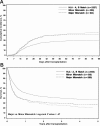HLA mismatching within or outside of cross-reactive groups (CREGs) is associated with similar outcomes after unrelated hematopoietic stem cell transplantation
- PMID: 17202313
- PMCID: PMC1874562
- DOI: 10.1182/blood-2006-06-032193
HLA mismatching within or outside of cross-reactive groups (CREGs) is associated with similar outcomes after unrelated hematopoietic stem cell transplantation
Abstract
The National Marrow Donor Program maintains a registry of volunteer donors for patients in need of a hematopoietic stem cell transplantation. Strategies for selecting a partially HLA-mismatched donor vary when a full match cannot be identified. Some transplantation centers limit the selection of mismatched donors to those sharing mismatched antigens within HLA-A and HLA-B cross-reactive groups (CREGs). To assess whether an HLA mismatch within a CREG group ("minor") may result in better outcome than a mismatch outside CREG groups ("major"), we analyzed validated outcomes data from 2709 bone marrow and peripheral blood stem cell transplantations. Three-hundred and ninety-six pairs (15%) were HLA-DRB1 allele matched but had an antigen-level mismatch at HLA-A or HLA-B. Univariate and multivariate analyses of engraftment, graft-versus-host disease, and survival showed that outcome is not significantly different between minor and major mismatches (P = .47, from the log-rank test for Kaplan-Meier survival). However, HLA-A, HLA-B, and HLA-DRB1 allele-matched cases had significantly better outcome than mismatched cases (P < .001). For patients without an HLA match, the selection of a CREG-compatible donor as tested does not improve outcome.
Figures

Similar articles
-
HLA-C antigen mismatch is associated with worse outcome in unrelated donor peripheral blood stem cell transplantation.Biol Blood Marrow Transplant. 2011 Jun;17(6):885-92. doi: 10.1016/j.bbmt.2010.09.012. Epub 2010 Sep 24. Biol Blood Marrow Transplant. 2011. PMID: 20870028 Free PMC article.
-
The effect of KIR ligand incompatibility on the outcome of unrelated donor transplantation: a report from the center for international blood and marrow transplant research, the European blood and marrow transplant registry, and the Dutch registry.Biol Blood Marrow Transplant. 2006 Aug;12(8):876-84. doi: 10.1016/j.bbmt.2006.05.007. Biol Blood Marrow Transplant. 2006. PMID: 16864058
-
High-resolution HLA matching in hematopoietic stem cell transplantation: a retrospective collaborative analysis.Blood. 2013 Oct 31;122(18):3220-9. doi: 10.1182/blood-2013-02-482547. Epub 2013 Sep 17. Blood. 2013. PMID: 24046013
-
Impact of HLA-DPB1 Matching on Outcome of Unrelated Transplant for Hematologic Malignant Diseases: A Systematic Review and Meta-analysis.Transplant Proc. 2019 Jul-Aug;51(6):1982-1989. doi: 10.1016/j.transproceed.2019.04.053. Transplant Proc. 2019. PMID: 31399180
-
Effect of HLA mismatch on acute graft-versus-host disease.Int J Hematol. 2013 Sep;98(3):300-8. doi: 10.1007/s12185-013-1405-x. Epub 2013 Jul 28. Int J Hematol. 2013. PMID: 23893313 Review.
Cited by
-
Characterization of Immunodominant BK Polyomavirus 9mer Epitope T Cell Responses.Am J Transplant. 2016 Apr;16(4):1193-206. doi: 10.1111/ajt.13598. Epub 2016 Feb 17. Am J Transplant. 2016. PMID: 26663765 Free PMC article.
-
Matching inside and outside the HLA molecule in allogeneic hematopoietic stem cell transplantation.Haematologica. 2016 Oct;101(10):1131-1132. doi: 10.3324/haematol.2016.150995. Haematologica. 2016. PMID: 27694500 Free PMC article. No abstract available.
-
Comparative study of two laboratory techniques for the detection of HLA-B27 in patients with axial spondyloarthritis: a cross-sectional analysis.Adv Rheumatol. 2024 May 23;64(1):42. doi: 10.1186/s42358-024-00383-x. Adv Rheumatol. 2024. PMID: 38783377
-
HLA diversity: detection and impact on unrelated hematopoietic stem cell donor characterization and selection.Int J Hematol. 2002 Aug;76 Suppl 2:152-4. doi: 10.1007/BF03165107. Int J Hematol. 2002. PMID: 12430917 Review.
-
Donor registries and search strategies.Methods Mol Biol. 2012;882:531-47. doi: 10.1007/978-1-61779-842-9_30. Methods Mol Biol. 2012. PMID: 22665254 Free PMC article.
References
-
- Rodey GE, Fuller TC. Public epitopes and the antigenic structure of the HLA molecules. Crit Rev Immunol. 1987;7:229–267. - PubMed
-
- Rodey GE, Neylan JF, Whelchel JD, Revels KW, Bray RA. Epitope specificity of HLA class I alloantibodies, I: frequency analysis of antibodies to private versus public specificities in potential transplant recipients. Hum Immunol. 1994;39:272–280. - PubMed
-
- Rodey GE. 2nd ed. Durango CO: De Novo; 2000. HLA Beyond Tears.
-
- Thompson J, Thacker L. Effect of HLA-DR and class I cross-reactive group matching on first cardiac transplants: an analysis of access and outcome. Transplant Proc. 1998;30:729. - PubMed
-
- Duquesnoy RJ, Takemoto S, De Lange P, et al. HLAmatchmaker: a molecularly based algorithm for histocompatibility determination, III: effect of matching at the HLA-A, B amino acid triplet level on kidney transplant survival. Transplantation. 2003;75:884–889. - PubMed
Publication types
MeSH terms
Substances
Grants and funding
LinkOut - more resources
Full Text Sources
Other Literature Sources
Medical
Research Materials
Miscellaneous

